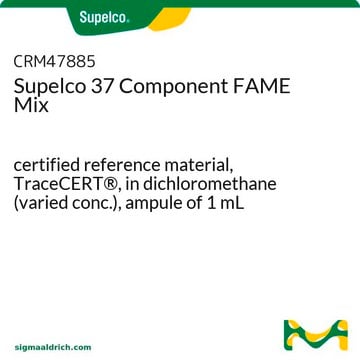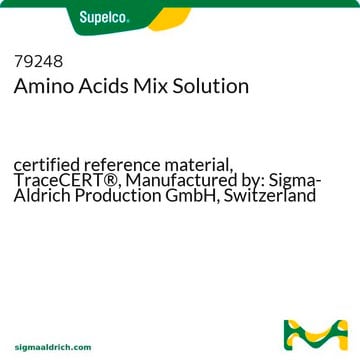89683
Tolueno
suitable for HPLC, ≥99.7% (GC)
About This Item
26 mmHg ( 25 °C)
Productos recomendados
densidad de vapor
3.2 (vs air)
Nivel de calidad
presión de vapor
22 mmHg ( 20 °C)
26 mmHg ( 25 °C)
Ensayo
≥99.7% (GC)
Formulario
liquid
temp. de autoignición
997 °F
caducidad
limited shelf life, expiry date on the label
lim. expl.
7 %
técnicas
HPLC: suitable
impurezas
≤0.05% water
residuo de evap.
≤0.001%
índice de refracción
n/D 1.496 (lit.)
n20/D 1.497
bp
110-111 °C (lit.)
mp
-93 °C (lit.)
densidad
0.865 g/mL at 25 °C (lit.)
resistencia del disolvente ε (Al2O3)
0.29
λ
1 cm path, H2O reference
Absorción UV
λ: 285 nm Amax: 1.0
λ: 310 nm Amax: 0.1
λ: 350 nm Amax: 0.01
cadena SMILES
Cc1ccccc1
InChI
1S/C7H8/c1-7-5-3-2-4-6-7/h2-6H,1H3
Clave InChI
YXFVVABEGXRONW-UHFFFAOYSA-N
¿Está buscando productos similares? Visita Guía de comparación de productos
Palabra de señalización
Danger
Frases de peligro
Consejos de prudencia
Clasificaciones de peligro
Aquatic Chronic 3 - Asp. Tox. 1 - Flam. Liq. 2 - Repr. 2 - Skin Irrit. 2 - STOT RE 2 Inhalation - STOT SE 3
Órganos de actuación
Central nervous system
Código de clase de almacenamiento
3 - Flammable liquids
Clase de riesgo para el agua (WGK)
WGK 3
Punto de inflamabilidad (°F)
39.9 °F - closed cup
Punto de inflamabilidad (°C)
4.4 °C - closed cup
Equipo de protección personal
Eyeshields, Faceshields, Gloves, type ABEK (EN14387) respirator filter
Elija entre una de las versiones más recientes:
Certificados de análisis (COA)
It looks like we've run into a problem, but you can still download Certificates of Analysis from our Documentos section.
Si necesita más asistencia, póngase en contacto con Atención al cliente
¿Ya tiene este producto?
Encuentre la documentación para los productos que ha comprado recientemente en la Biblioteca de documentos.
Active Filters
Nuestro equipo de científicos tiene experiencia en todas las áreas de investigación: Ciencias de la vida, Ciencia de los materiales, Síntesis química, Cromatografía, Analítica y muchas otras.
Póngase en contacto con el Servicio técnico









